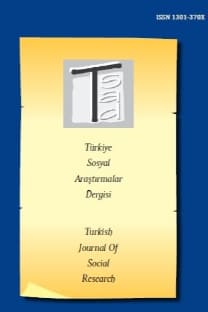THE SCOPE AND USE OF ESP IN FOREIGN AND TURKISH CONTEXT
YABANCI VE YEREL ORTAMDA ÖZEL AMAÇLI İNGİLİZCENİN KAPSAMI VE KULLANIMI
___
- ALLEN, J.P.B. and WIDDOWSON. H.G. (1974). "Teaching the Communi- cative use of English", International Review of Applied Linguistics XII, I.
- BAŞTÜRKMEN, H. (1998). "Refining Procedures: A Needs Analysis Pro- ject at Kuwait University". Forum, Vol: 36 (4) Oct-Dec.
- BERWICK, R. (1989). Second Language Curriculum. Chapter 4 - Needs as- sessment in language programming: from theory to practice. New York: CUP. (Online publication 2012).
- BHATIA, A.T. (1986). "ESP for students of Science" in A.C. Newton (Ed.). A Forum Anthology: Selected Articles from the English Teaching Forum. Vol: 66- 70. Washington D.C.: USIS Agency.
- BRINDLEY, G. (1989). The role of needs analysis in adult ESL program design. In: R. K. Johnson (Ed). The Second Language Curriculum, Cambridge: Cambridge University Press.
- BROWN, J.D. (1995). Needs Analysis. The elements of language curriculum: A systematic approach to program development, New York: Heinle and Heinle.
- DAY, J. and KRZANWSKI, M. (2011) Teaching English for Specific Purpos- es: An Introduction. Cambridge. Cambridge University Press.
- EARLY, P. (1981). The ESP teacher's role-implications for the "Knower- client" relationship. English Language Teaching Document, Vol: 112, 42-52, British Council.
- ELKILIÇ, G. (1994).An Analysis of English Language Needs of Veteri- nary Medicine Students at Selçuk University. An Unpublished Master's Thesis. Bilkent University, Ankara, Turkey.
- EL-SAKRAN, A. T. (2012). "Evaluation of an English for Specific Purposes (ESP) Book for Students of Islamic and Arabic Studies1", English for Specific Pur- poses World ISSN 1682 -3257 Issue 3 (4), Vol: 12.
- EWER, J.R. and LATORRE, G. (1969). A Course in Basic Scientific English. London: Longman.
- GLENDINNING, E. H. and HOLMSTRÖM, B. A. S. (2007). English in Medicine, Cambridge: University Press.
- GÜNDÜZ, N. (1999). An Analysis of Students English Needs in the English Language and Literature Department of Selçuk University (Yayınlanmamış Yüksek Lisans Tezi). Ankara: İhsan Doğramacı Bilkent Üniversitesi: SBE.
- HUTCHINSON and WATERS, A. (1987). English for Specific Purposes: A learning-centred approach. Cambridge: Cambridge University Press.
- ISANI, S. (2013). "Quo vadis? Past, present and future aspects of ESP". The Handbook of English for Specific Purposes In ASP 64:2013 Domaines, territoires et frontières en anglais de spécialité
- JORDAN, R.R. (1997). English for Academic Purposes: A Guide and Resource Book for Teachers, Cambridge: Cambridge University Press.
- KENNEDY, C. and BOLITHO, R. (1984). English for Specific Purposes. London: Macmillan.
- LIN, C. H. and WU, W. C. and HUANG, Y. T. (2013). "English for Specific Purposes (ESP) for Hospitality College Students and Hotel Employees", Internation- al Journal of Education and Research Vol: 1 No. 8 August 2013. Taiwan http://www.ijern.com/journal/August-2013/15.
- MACKAY, R.and MOUNTFORD, A. (1978). English for Specific Purposes. London: Longman.
- MCDONOUGH, J. (1984). ESP in perspective : A Practical Guide, London: Collins ELT.
- MUNBY, J. (1978). Communicative Syllabus Design, Cambridge: Cambridge University Press.
- NUNAN, (1988). The learner-centered Curriculum, Cambridge: Cambridge University Press.
- OĞUZ, A. B. (1997). Academic Reading in Focus. Ankara: Gazi University.
- PALTRIDGE and S. STARFIELD: The Handbook of English for Specific Purposes. Boston:Wiley-Blackwell.
- RICHARDS, J. C. (1990). The Language Teaching Matrix, Cambridge: Cambridge University Press.
- RICHTERICH, R. and CHANCEREL, J.L. (1980). Identifying the Needs of Adults Learning a Foreign Language, Oxford: Pergamon Press.
- SELINKER, L. and TRIMBLE, M. (1976). "Presuppositional Rhetorical In- formation in EST Discourse", TESOL Quarterly, Vol: 10 (3).
- SEYMOUR, A. (1999). "What Students Say they Need". Bilkent University Conference. Unpublished Speech.
- STREVENS, P. (1977). "Special-purpose language learning: a perspective", Language Teaching and Linguistics, N. 3, Vol: 10.
- STREVENS, P. (1980). Teaching English as an International Language: From Practice to Principle. Oxford: Pergamon Press.
- STREVENS, P. (1988). "ESP after twenty years: A re-appraisal". In M. Tickoo (Ed.), ESP: State of the Art. Singapore: SEAMEO Regional Centre.
- SWALES, J.M. (1988). Episodes in ESP. Hempstead: Prentice Hall Interna- tional.
- SWALES, J.M. (1990). Genre Analysis: English in Academic and Research Set- tings. Cambridge: Cambridge University Press.
- WETTE, R. and HAWKEN S. J. (2016). "Measuring gains in an EMP course and the perspectives of language and medical educators as assessors", English for Spe- cific Purposes. Vol: 42.
- WIDDOWSON, H. J. (1978). Teaching Language as Communication, Lon- don: Oxford University Press.
- WILLIAMS, C. (2014). "The future of ESP studies: building on success, ex- ploring new paths, avoiding pitfalls" ASP 66 Intersections - l'anglais de spécialité, creuset ultidomaine.
- ISSN: 1301-370X
- Yayın Aralığı: 3
- Başlangıç: 2015
- Yayıncı: AKADEMİSYENLER BİRLİĞİ DERNEĞİ
Alkol ve Madde Bağımlılığı Olan Bireylerin Başa Çıkma Tutumları
Ercüment Erbay, Nihan Oğuz, Buğra Yıldırım, Engin Fırat
ÜNİVERSİTE ÖĞRENCİLERİNİN ENGELLİLERE YÖNELİK TUTUMLARININ BELİRLENMESİ
Agah Tugrul KORUCU, Ertuğrul USTA, Cem SEZER
THE SCOPE AND USE OF ESP IN FOREIGN AND TURKISH CONTEXT
I. DÜNYA SAVAŞI'NIN ARDINDAN YENİDÜNYA DÜZENİNE DOĞRU: 1919 PARİS BARIŞ KONFERANSI
Ali Erhan ERTAN, Tevfik ORÇUN ÖZGÜN
NEY METOTLARINDAKİ MAKAM ANLATIMLARINDA YER ALAN ÖRNEK ESERLERİN İNCELENMESİ
TÜRKİYE'DE BİYO-İKTİDAR AÇISINDAN SAĞLIK HİZMETLERİ VE KADIN
DEĞERLER EĞİTİMİNİN ÖĞRENCİ DAVRANIŞLARINA ETKİSİNİN VELİ GÖRÜŞLERİNE GÖRE İNCELENMESİ
TÜRKİYE’DE BİYO-İKTİDAR AÇISINDAN SAĞLIK HİZMETLERİ VE KADIN
